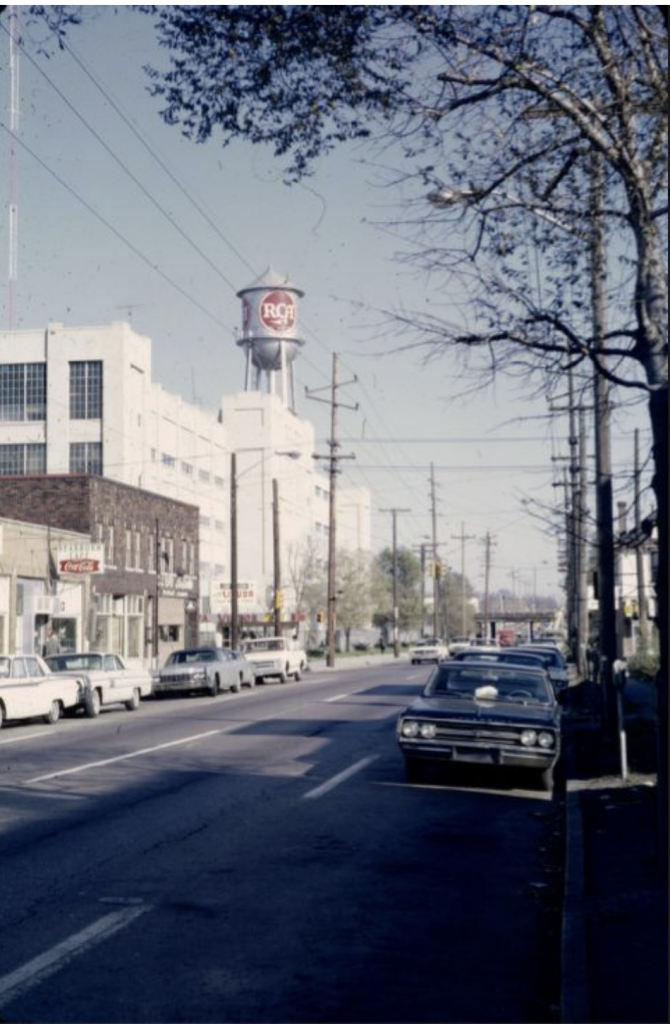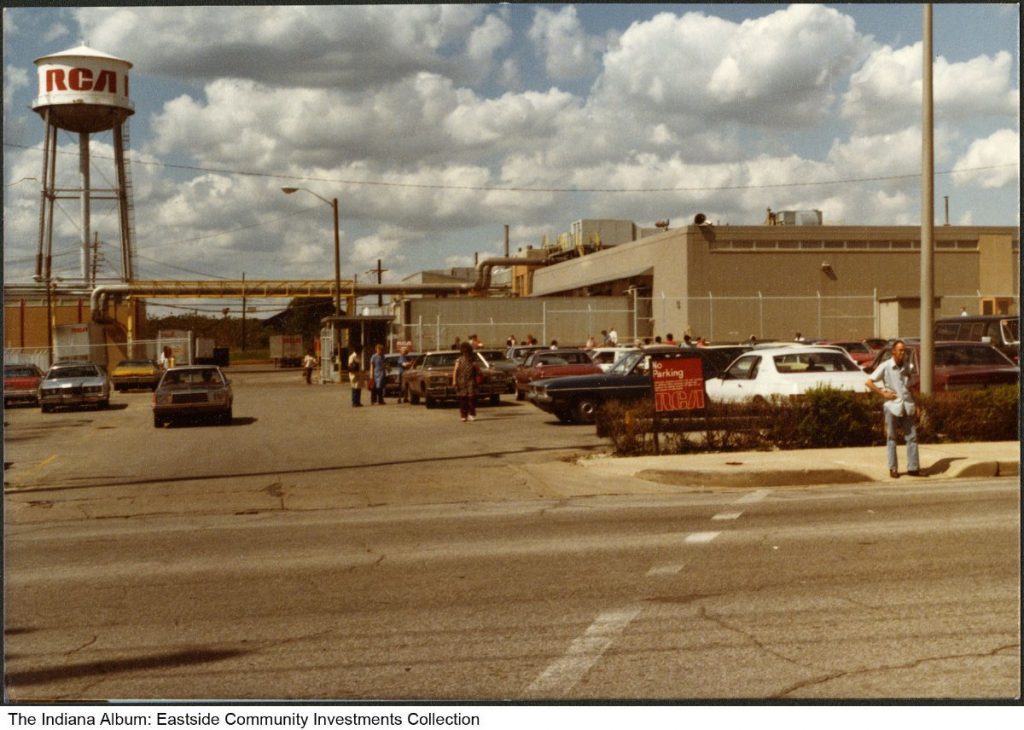Thomson traces its Indianapolis roots through the Radio Corporation of America (RCA) to a small Westinghouse light bulb factory at the corner of LaSalle and Michigan streets in the early 1920s. Initially formed to market radio equipment produced by General Electric (GE) and Westinghouse, RCA cut free from its corporate parents within a decade and acquired the assets and manufacturing capability of the Victor Talking Machine Company of Camden, New Jersey.

In 1930, it purchased the inactive Westinghouse factory in Indianapolis, which had been converted to radio tube production. The Great Depression dampened the market for radios, and RCA stopped tube production in the city altogether in late 1930. When the company resumed operations in July 1936, displacing Works Progress Administration offices then housed at the plant site, it manufactured the Photophone Sound System used for motion picture sound. By the end of 1937, radio tube manufacturing had again started in Indianapolis.
Within three years, the plant was making sound equipment, public address systems, radio tubes, and recording gear. An ambitious expansion plan announced in early 1939 added 1,000 new jobs to the local RCA payroll. Sound equipment rolled off Indianapolis production lines for both the 1939 New York World’s Fair and the San Francisco Exposition. A new business also began in Indianapolis—pressing phonograph records.
International tensions in late 1940 led to the Navy’s decision to spend more than $2.7 million to expand RCA’s facilities in Camden, New Jersey (the company’s research base) and in Indianapolis. After Pearl Harbor, the Indianapolis plant shifted to World War II production, including a land mine detector used effectively during the Normandy invasion.
Conversion to civilian production after the war was swift, and by 1947 the plant was building electronic television components even before Indianapolis citizens had a TV station. In 1950, employment at the city’s RCA plant peaked at 8,200. Ten years later, RCA moved its consumer electronics headquarters to Indianapolis from New Jersey. Soon, Indianapolis was the site of the home electronics division’s design, engineering, research, marketing and sales, and administrative functions.

RCA underwent tremendous changes in the 1970s. Operations in Indianapolis continued to focus on consumer electronics, including the development of the ill-fated Videodisc system that lost out to the videocassette recorder as the preferred method of viewing recorded programs.
In 1986, General Electric acquired RCA in what was (at the time) the largest non-oil merger ever attempted. GE moved its own consumer electronics division (based in Portsmouth, Virginia) to Indianapolis shortly after the purchase. A third brand, ProScan, a premier line of color TVs, VCRs, and laserdisc players, had limited national distribution.
GE sold the rights to make RCA, ProScan, and GE-branded televisions and other consumer electronics to the French national company, Thomson Consumer Electronics, in 1988. With these acquisitions, Thomson became the fourth-largest consumer electronics group. Only Japanese companies Sony and Matsushita and Royal Philips Electronics of the Netherlands were bigger. Thomson’s major manufacturing centers in Indiana included the world’s largest color television assembly plant at Bloomington; the Marion television tube plant, which produced tubes up to 35 inches in size (the first to manufacture 35-inch direct-view tubes in America); and the Indianapolis plastic components plant, which manufactured printed circuit boards for color TVs, plastic cabinets, remote control units, and other component parts. The corporation entered into an agreement with Philips to develop high-definition television to compete with Japanese consortiums in 1992.
Thomson signaled the growing importance of its North American market in 1992 when it constructed a new U.S headquarters, moving from Indianapolis to . The company hired renowned architect and Indianapolis native for its design, and it opened in 1994. The corporation also became involved in the development of satellite television. It launched the RCA Digital Satellite System, which allowed users to receive television channels through an 18-inch satellite dish, in 1993. Thomson embarked on this project to position it as a leader in digital television technologies and products around the world.

In 1994, Thomson Consumer Electronics became Thomson Multimedia, recognizing the importance of developing a wide spectrum of interrelated consumer entertainment media products. The corporation also solidified its commitment to Indianapolis and its environs when it reached a deal with the Indianapolis to change the name of the , home of the , to the RCA Dome. Thomson agreed to pay the city $10 million over 10 years, and city officials offered two 5-year renewal options. The stadium carried the RCA name until it was imploded in 2008 to make way for and an expansion of the .
More than 2,000 people were employed at the Carmel headquarters in the mid-1990s, while the company had 17,000 employees worldwide. Thomson Multimedia led the U.S. consumer electronics market with a 25 percent share, and by 1997, North America accounted for two-thirds of the company’s $6.3 billion of revenue. Yet, Thomson also experienced $2.55 billion in losses because of the risks it had taken to compete at the top levels of the consumer electronics industry. To wipe out debt, the company closed the Bloomington television production plant and moved it to Juarez, Mexico, in 1998. The French government, under conservative President Jacques Chirac, a strong proponent of privatization, returned Thomson to private ownership, and the company opened to public shareholding in 1999 on the New York and Paris stock exchanges.

In December 2000, Thomson Multimedia reached an agreement to acquire the professional broadcasting business of Philips Electronics and then purchased Hollywood film processing Technicolor from Carlton Communications in a deal valued at $2.1 billion. As the industry moved from analog to digital broadcasting and wireless digital distribution of films and other entertainment media, the company aimed to use Technicolor as the underpinning of its digital entertainment delivery strategy. Technicolor partnered with digital media technology company Qualcomm to provide an open standard distribution system for digital cinema. Using encryption and compression technology, Technicolor, which already was one of the world’s largest producers of DVDs and videocassettes, entered the digital film processing industry.
Thomson projected that the addition of Technicolor and digital film processing would lead to increased earnings. The company, however, continued to make such products as cathode-ray tubes, which with the introduction of high-definition televisions were becoming obsolete. In 2004, the company began moving away from making electronics for consumers to serve those “in the content creation, distribution and access” businesses. It offered professional broadcast equipment; post-production and replication video services; and broadband access products, including set tops. This change caused a drop in the number of people who worked out of the Thomson Carmel facility, and sublet one of the company’s buildings to consolidate its administrative offices in 2007. To mark the transition to the professional video market, Thomson, in January 2010, rebranded the entire company after its American film technology subsidiary, renaming it Technicolor SA. The U.S. subsidiary in Carmel became Technicolor USA, Inc.
With this change, Thomson left manufacturing, and the company announced the closure of its Indianapolis-area operations, stating that it planned to move work to a plant in Lawrenceville, Georgia. Approximately 650 employees remained in the second Carmel building until all operations finally were shuttered in 2017. Technicolor continued to operate in 27 media markets globally and had three primary divisions: electronics, production services, and DVD services. It filed for bankruptcy in June 2020 due to a continued shift away from traditional media consumption and to delays in film releases and theatrical production imposed by the COVID pandemic. The company completed financial restructuring in France in fall 2020.

Help improve this entry
Contribute information, offer corrections, suggest images.
You can also recommend new entries related to this topic.

